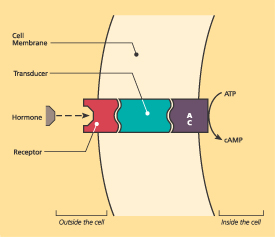![]()
Home | <<Previous | Next>>
 Rodbell
knew that a number of different hormones increased cAMP (the second messenger)
in his purified fat cells. Together with postdoctoral fellow Lutz Birnbaumer,
he discovered that each hormone acts through a specialized receptor, but all
hormones stimulate the same adenylyl cyclase (AC) molecule. This has been called
the "ping pong ball model."
Rodbell
knew that a number of different hormones increased cAMP (the second messenger)
in his purified fat cells. Together with postdoctoral fellow Lutz Birnbaumer,
he discovered that each hormone acts through a specialized receptor, but all
hormones stimulate the same adenylyl cyclase (AC) molecule. This has been called
the "ping pong ball model."
Rodbell thought it unlikely that so many receptors could interact directly with
a single AC molecule. He predicted that there must be a go-between that carries
the signal from each receptor to the AC molecule. Rodbell used the word "transducer"
for this go-between, using a term from computer science.
"We are working hard in the lab these days with a sense of excitement that we may shortly have some important answers to the question of how hormones activate adenylate cyclase systems." --Letter from Martin Rodbell to Mr. Anil Joshi, November 15, 1973
 To
find the transducer that he predicted, Rodbell turned from fat cells to liver
cells. Two things made this work possible. First, David Neville, of the National
Institute of Mental Health, devised a method for isolating large amounts of
liver cell membranes. Second, Rodbell developed
a technique for measuring the binding of the hormone glucagon to its receptor
in those membranes. With the liver cell membranes and a method to test them
in hand, Rodbell and his team (Lutz Birnbaumer, H. Michiel J. Krans, and Stephen
L. Pohl) tested the response of the cell membranes to the hormone glucagon.
Their experiments proved that a molecule called guanosine triphosphate (GTP)
was necessary for the transmission of a message from a glucagon-bound receptor
to AC. Although Rodbell did not identify and isolate the transducer, he proved
that it existed, was dependent on GTP, and was an integral feature of all receptors
that increase the activity of AC. Alfred G. Gilman shared the Nobel Prize with
Rodbell for finding the transducer, called the "G-protein."
To
find the transducer that he predicted, Rodbell turned from fat cells to liver
cells. Two things made this work possible. First, David Neville, of the National
Institute of Mental Health, devised a method for isolating large amounts of
liver cell membranes. Second, Rodbell developed
a technique for measuring the binding of the hormone glucagon to its receptor
in those membranes. With the liver cell membranes and a method to test them
in hand, Rodbell and his team (Lutz Birnbaumer, H. Michiel J. Krans, and Stephen
L. Pohl) tested the response of the cell membranes to the hormone glucagon.
Their experiments proved that a molecule called guanosine triphosphate (GTP)
was necessary for the transmission of a message from a glucagon-bound receptor
to AC. Although Rodbell did not identify and isolate the transducer, he proved
that it existed, was dependent on GTP, and was an integral feature of all receptors
that increase the activity of AC. Alfred G. Gilman shared the Nobel Prize with
Rodbell for finding the transducer, called the "G-protein."
"It was a period in which my life experiences had kaleidoscoped into a wonderful sense of creativity shared with not only my immediate colleagues but with scientists from all over the world." --Martin Rodbell
 Rodbell
also developed strong evidence for a second type of transducer—one linked to
receptors that inhibit functions within the cell. He accurately predicted that
other pairs of transducers and receptors would be found that regulate molecules
other than AC.
Rodbell
also developed strong evidence for a second type of transducer—one linked to
receptors that inhibit functions within the cell. He accurately predicted that
other pairs of transducers and receptors would be found that regulate molecules
other than AC.
Third Image: Courtesy of Ann Butler Jones
Home | <<Previous | Next>>